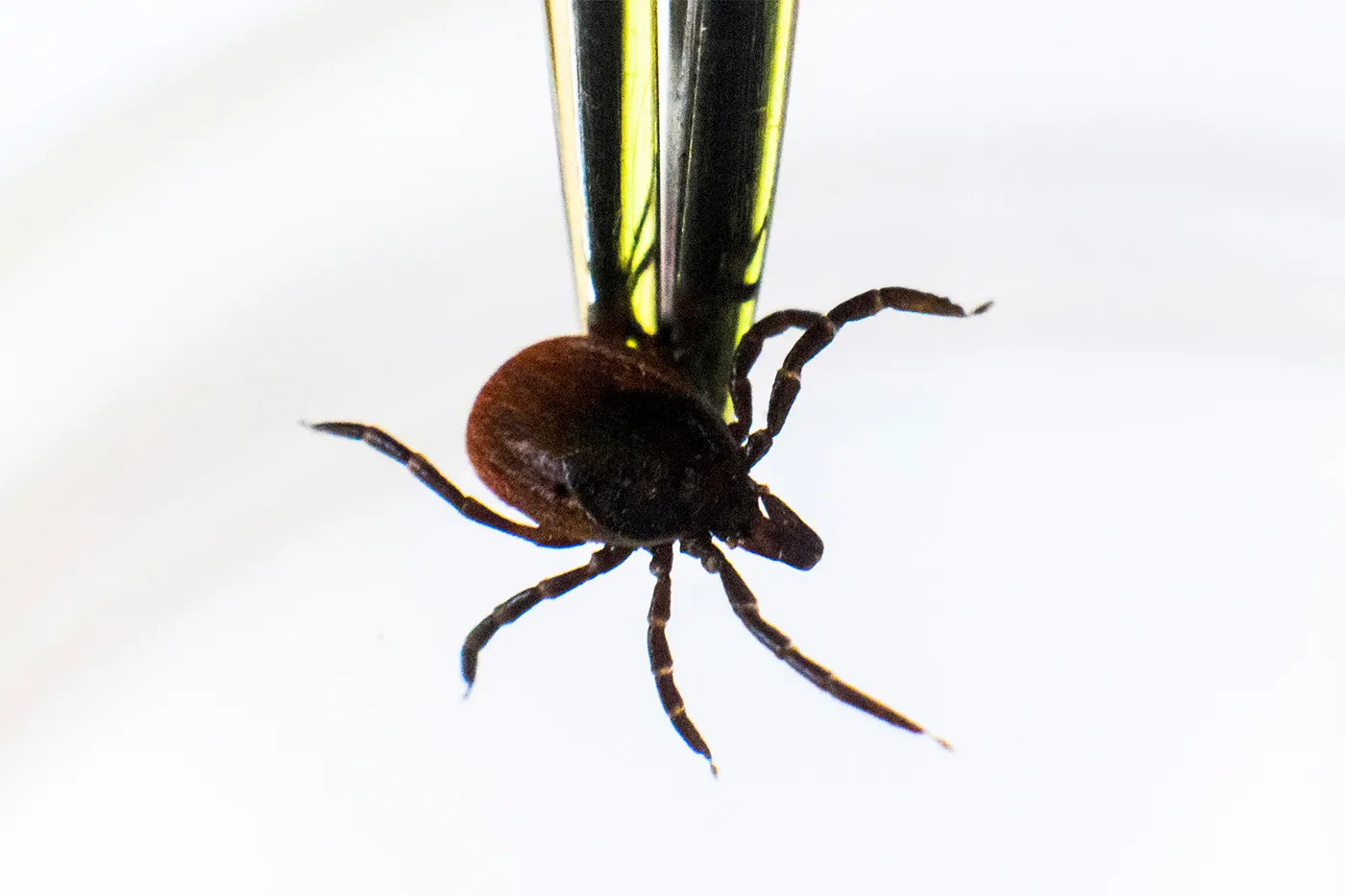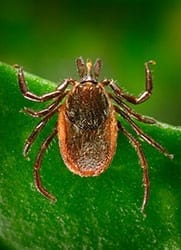
A tick is held by a pair of tweezers
Every year, tens of thousands of new Lyme disease patients find that their symptoms persist even after the standard course of antibiotic treatment.
Instead of being cured, they find their lives upturned by chronic Lyme, also called persistent or post-treatment Lyme. Symptoms include bone-deep fatigue, cognitive difficulties, arthritis, muscle and joint pain and intermittent fevers, chills and sweats that can go on for months or years.
While medical solutions have proved elusive, a researcher at Northeastern University says he has developed a treatment for Lyme disease that could prevent chronic Lyme from developing in the first place.
Kim Lewis, distinguished professor of biology and director of Northeastern’s Antimicrobial Discovery Center, says human trials of his discovery may begin as early as next year.
Final toxicity trials will continue this summer, but so far the treatment—an antibiotic known as hygromycin A—has not been toxic in animals and has effectively cleared Lyme disease in mice, Lewis says.
He says the real promise of hygromycin A in preventing chronic Lyme is that it is a targeted antibiotic that selectively kills Lyme disease-causing bacteria without damaging the beneficial bacteria in the patient’s microbiome.
According to Lewis’ theory, the broad spectrum antibiotics traditionally prescribed for Lyme disease, doxycycline and amoxicillin, cause havoc in the gut by wiping out the healthy balance of bacteria.
“The microbiome has now been linked to almost every aspect of our health, especially the development of the immune system,” Lewis says.
A healthy gut serves many roles, according to the National Institutes of Health, including preventing disease, modulating the immune system, supporting metabolism and aiding brain function.
It’s not surprising to Lewis that a depleted microbiome could lead to many of the frustrating and seemingly endless symptoms associated with chronic Lyme disease.
He found in previous research that patients with long-term Lyme disease symptoms tend to have a gut microbiome that is distinct from healthy patients.
“I think the contributing factor is that broad spectrum antibiotics really damage the microbiome, and that in turn changes the immune system and you get an immunological disorder with symptoms like fatigue, foggy mind, etc.,” Lewis says.
“I hope that this compound hygromycin A will decrease” cases of chronic Lyme in patients treated for acute Lyme, he says.
The need is dire.
The Centers for Disease Prevention and Control now estimates that each year up to 476,000 people in the United States get Lyme disease from the bite of a deer tick, a substantial increase in cases from years before.
Lewis estimates that 10% of people treated for acute cases of Lyme go on to develop post-treatment or chronic Lyme. Some advocacy groups for people with tick-borne diseases, such as the Bay Area Lyme Foundation, say persistent Lyme could account for as many as 34% of Lyme cases.
Made by a bacterium found in the soil, hygromycin A has been a known antimicrobial since 1953, Lewis says.
“Nobody really cared about that compound because it’s very weak against regular bacteria,” he says. “What we discovered is that it is indeed very weak against regular pathogens, but exceptionally potent against spirochetes.”
Spirochetes are spiral-shaped bacteria found in the pathogens causing Lyme disease, syphilis and yaws.
Lewis’ team has licensed the compound to Flightpath, a biotech company focused on Lyme disease, to perform development studies and pursue production of the treatment.
“Clearly, this needs to move to industrial production,” says Lewis, scientific co-founder of Flightpath.
So far hygromycin A cleared Lyme disease in a mouse model and awaits the final stage of animal toxicity studies, which will take place this summer.
Lewis hopes that the antibiotic proves to be a silver bullet in preventing chronic Lyme. Human trials, he says, may start as soon as next year.
Original Article: Could ‘new’ antibiotic treatment prevent chronic Lyme disease?
More from: Northeastern University
The Latest Updates from Bing News
Go deeper with Bing News on:
Lyme disease
- Tampa woman claims a COVID booster led to a late-stage Lyme disease diagnosis
Tara Foti got a COVID-19 booster shot back in 2021. Now, she says it reactivated Lyme disease, with debilitating symptoms.
- Was Lyme disease spread as a bioweapon? No, that theory is Pants on Fire!
Further, Diuk-Wasser said, Lyme disease would be a "terrible bioweapon" because the bacteria and ticks grow very slowly, need specific habitats to survive and are transferred through tick bites, which have a slower transmission rate than diseases spread through other means, such as respiratory viruses.
- Long Dismissed, Chronic Lyme Disease Is Finally Getting Its Moment
Over the next two decades, Gray’s neurological issues continued and she progressively developed new symptoms: numbness and tingling in her back, chronic pain, anxiety, and an uncontrollable rage that made her feel like an entirely different person. She knew something was seriously wrong, but she didn't know what. “I was scared to death,” she says.
- Is Lyme disease contagious?
Lyme disease is not contagious. It does not spread from person to person. To become infected with the bacteria, a person must have been bitten by a tick that is infected with the bacteria. According to the CDC, in most cases, a tick must be attached for 36 ...
- Bella Hadid returns to work after Lyme disease treatment
The 26-year-old model took a step back from her career in order to undergo treatment for Lyme disease - which she was first diagnosed with in 2012 - but she revealed to fans on Wednesday (09.08.23) night she was back on set for a new job. Bella shared a ...
Go deeper with Bing News on:
Chronic Lyme
- Tick Population Increases, US Warns of Lyme Disease Threat
Summer not only means exciting outings, but there is the risk of tick bites. Those going to the US are asked to be alert.
- ‘RHONY’ alum Leah McSweeney reveals Lyme disease diagnosis, asks for ‘success stories of healing’
The former Bravo star, who is suing both the network and Andy Cohen for unrelated reasons, took to her Instagram Story to share a screenshot of her test results.
- 'It's A New Infection Not Chronic': Reality TV Star Leah McSweeney On Her Lyme Disease Diagnosis That Left Her 'Shook'
Leah McSweeney is shaken by her Lyme infection diagnosis! The Real Housewives of New York fame shared a post of her recent blood test on Instagram and broke the news of her Lyme disease diagnosis.
- Leah McSweeney ‘Shook’ After Lyme Disease Diagnosis
The post Leah McSweeney ‘Shook’ After Lyme Disease Diagnosis appeared first on Reality Tea. The penalties are a result of a rule-breaking incident that transpired in 2022, when a booster and ...
- Picture this: Traveling with a chronic illness leads to a whole new journey
Through their photographs, I get to share in my family’s enthusiasm, see the world through their eyes, learn what they deem is important. For my husband: an emerald-green mallard, lounging on the ...












